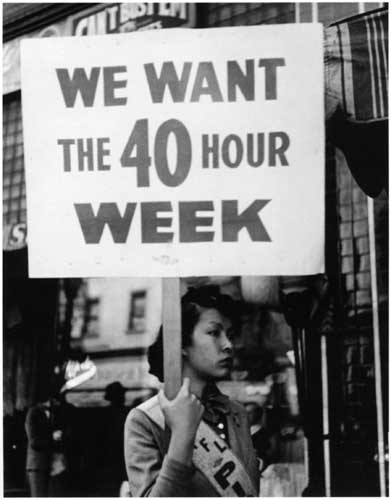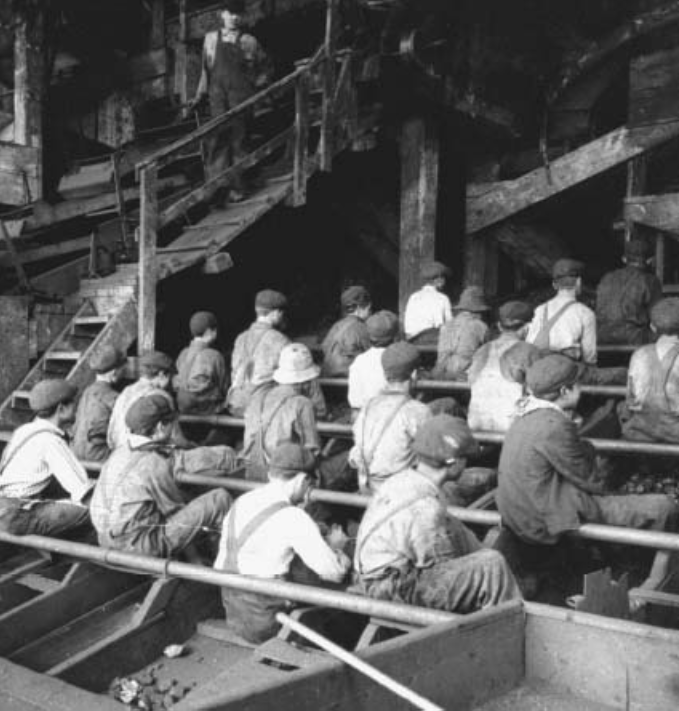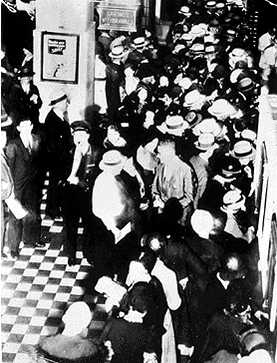Historical Context
Development of the New Deal
Signing of the FLSA
Short Term Impact
Long Term Impact
Written Work

We Want the 40 Hour Week, Communications Workers of America Local 6012
U.S. workers in the early 1900s faced vastly different working salaries compared to their modern counterparts. Male laborers received an average yearly salary of $687, or about $16,063 today, while women received half that. Workers also worked an average of 55 hours a week. The long work hours and low pay led to many workers' strikes in the 1910s, with over 3,789 just in 1916.
"On the first pay after the law went into effect, the employers cut the wages proportionately to the cut in-hours and the wages were on the average of $7 and $8 a week at that time, and the highest pay to loom fixers and more highly skilled were getting possibly, $15 and $20. It was a margin between mere subsistence and starvation and so there was a spontaneous strike."
-
Elizabeth Gurley Flynn, 1962, recount on the Bread and Roses Strike
"Child labor and poverty are inevitably bound together and if you continue to use the labor of children as the treatment for the social disease of poverty, you will have both poverty and child labor to the end of time."
-
Grace Abbott (American Social Worker & Child Labor Reformer Director, Children’s Bureau, U.S. Department of Labor 1917–1934)
The employment of children below the age of 18 was a common practice in America until it began to be viewed as exploitative in the early 20th century. Children faced low salaries, dangerous work in mines or coal breakers, and a lack of education. The practice was common because many families struggled financially due to low working salaries since no federal minimum wage existed.
“There is work that profits children, and there is work that brings profit only to employers. The object of employing children is not to train them, but to get high profits from their work.”
- Lewis Hine (Child Labor Photographer), 1908

Child laborers picking slate at a coal breaker in the 1900s
Breaker Boys, c. 1913, Library of Congress (cph.3a12538)
A significant factor in the creation of the Fair Labor Standards Act was the Great Depression. Sparked in 1929, it was a worldwide economic downturn caused by slowing consumer demand, mounting consumer debt, a decrease in industrial production, and the rapid and reckless expansion of the U.S. stock market. These factors led to a devastating stock market crash on October 24, 1929.

Americans withdrawing their saving after the recent stock market crash
The Rush to Withdraw Savings, c. 1930, GALE
Hoover's response to the depression was underwhelming, assuring the public that the economic disaster was part of a "business cycle" and would run its course. He later attempted his own "New Deal," but it was largely unsuccessful in combating the depression. Because Hoover failed in handling the depression, Franklin D. Roosevelt defeated him in the next election with promises to make effective changes against the Great Depression.
"Two courses were open to us. We might have done nothing. That would have been utter ruin. Instead, we met the situation with proposals to private business and to the Congress of the most gigantic program of economic defense and counterattack ever evolved in the history of the Republic. We put that program in action."
- Herbert Hoover, quoted from his speech after accepting the republican presidential nomination, 1932